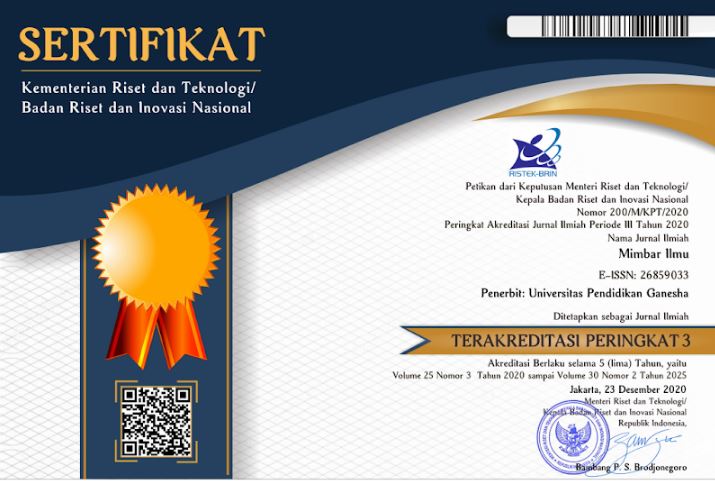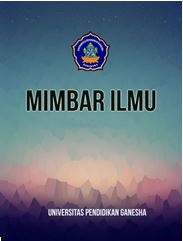Materi Ajar Digital Berbasis Kearifan Lokal Pada Topik Sumber Energi Panas Untuk Kelas V Sekolah Dasar
DOI:
https://doi.org/10.23887/mi.v27i2.47296Kata Kunci:
digital, validity, practically, local wisdomAbstrak
The COVID-19 pandemic has led to the implementation of online learning activities. Online learning activities have not run optimally due to the lack of teaching materials and digital skills possessed by teachers. This study aims to create android-based local wisdom digital teaching materials on the topic of heat energy sources for fifth grade elementary school. The development model used in this study is the ADDIE model. The test subjects consisted of 1 material expert, 1 media expert, 2 teachers and 12 students. There are two data in this study, namely qualitative data and quantitative data. Data collection techniques using a questionnaire technique. The data collected was then analyzed descriptively quantitatively. The validity of android-based local wisdom digital teaching materials from material experts with a percentage of 96.5% and from media experts getting 96.5% in the very good category. The results of the practicality of android-based local wisdom digital teaching materials based on teacher assessments obtained 99.4% and the percentage of students' practicality tests 98.7%. The results showed that the local wisdom digital teaching materials based on Android on the topic of heat energy sources for grade V elementary school were valid and practical to use. The implications of this research are expected to help students understand learning materials during online learning.
Referensi
Aisyah. (2019). Analisis Kebutuhan Bahan Ajar Digital Interaktif untuk Pembelajaran Ilmu Pengetahuan Alam Abad 21. Jurnal Basicedu, 3(2), 524–532. https://doi.org/10.31004/basicedu.v5i6.1733. DOI: https://doi.org/10.31004/basicedu.v5i6.1733
Aka, K. . (2017). Pemanfaatan Teknologi Informasi dan Komunikasi (TIK) sebagai Wujud Inovasi Sumber Belajar di Sekolah Dasar. 1, 28–37. https://doi.org/10.30651/else.v1i2a.1041.
Amaliah, I., & Sudihartinih, E. (2019). Pengembangan Bahan Ajar Konsep Pecahan Berbantuan Multimedia Untuk Meningkatkan Kemampuan Pemahaman Matematis Siswa Di Sekolah Inklusi. Jurnal Pendidikan, 4(2), 6–10. https://journal.unesa.ac.id/index.php/jp/article/view/5163.
Astuti, I. A. D., Sumarni, R. A., & Saraswati, D. L. (2017). Pengembangan Media Pembelajaran Fisika Mobile Learning berbasis Android. Jurnal Penelitian & Pengembangan Pendidikan Fisika, 3(1), 57. https://doi.org/10.21009/1.03108. DOI: https://doi.org/10.21009/1.03108
Ceryna Dewi, N. K., Anandita, I. B. G., Atmaja, K. J., & Aditama, P. W. (2018). Rancang Bangun Aplikasi Mobile Siska Berbasis Android. SINTECH (Science and Information Technology) Journal, 1(2), 100–107. https://doi.org/10.31598/sintechjournal.v2i1.291. DOI: https://doi.org/10.31598/sintechjournal.v2i1.291
Curwen, M. S., Miller, R. G., White-smith, K. a., & Calfee, R. C. (2010). Increasing Teachers ’ Metacognition Develops Students ’ Higher Learning during Content Area Literacy Instruction : Findings from the Read-Write Cycle Project. Issues in Teacher Education, 19(2), 127–151. https://digitalcommons.chapman.edu/education_articles/6/.
Darmayanti, P. S., & Lastari, N. K. H. (2022). An Analysis Of Students ’ Responses Towards The Implementation Of Digital Teaching Materials For. Jurnal Pendidikan Teknologi Dan Kejuruan, 19(1), 35–44. https://doi.org/10.23887/jptk-undiksha.v19i1.43000.
Darwanto. (2022). Bahan Ajar Digital Sebagai Alternatif Pembelajaran Jarak Jauh dan Mandiri (Pengembangan Bahan Ajar Mata Kuliah Teori Graf). Jurnal Basicedu, 6(1), 1055–1063. https://doi.org/10.31004/basicedu.v6i1.2119. DOI: https://doi.org/10.31004/basicedu.v6i1.2119
Faisal, M., Hotimah, Nurhaedah, AP, N., & Khaerunnisa. (2020). Peningkatan Kompetensi Guru Sekolah Dasar dalam Mengembangkan Bahan Ajar Digital di Kabupaten Gowa. Publikasi Pendidikan, 10(3), 266–270. https://doi.org/10.26858/publikan.v10i3.16187.
Fansury, A. H., Januarty, R., Rahman, A. W., & Syawal. (2020). Digital Content for Millennial Generations: Teaching the English Foreign Language Learner on COVID-19 Pandemic. Journal of Southwest Jiaotong University, 55(3). https://doi.org/10.35741/issn.0258-2724.55.3.40. DOI: https://doi.org/10.35741/issn.0258-2724.55.3.40
Hasanah, U., Marini, A., & Maksum, A. (2021). Multicultural education-oriented digital teaching materials to improve students’ pluralist attitudes. Jurnal Prima Edukasia, 9(1), 118–126. https://doi.org/10.21831/jpe.v9i1.35503. DOI: https://doi.org/10.21831/jpe.v9i1.35503
Khusna, N., Shufa, F., & Artikel, S. (2018). Pembelajaran Berbasis Kearifan Lokal Di Sekolah Dasar : Sebuah Kerangka Konseptual. Inopendas Jurnal Ilmiah Kependidikan, 1(1), 48–53. https://doi.org/10.24176/jino.v1i1.2316. DOI: https://doi.org/10.24176/jino.v1i1.2316
Kiriana, I. N. (2021). Increase Student Learning Interest in Covid-19 with Digital Teaching Materials. Journal of Education Technology, 5(2), 322. https://doi.org/10.23887/jet.v5i2.33997. DOI: https://doi.org/10.23887/jet.v5i2.33997
Labib, U. A., & Yolida, B. (2019). Pengembangan Aplikasi berbasis Android yang Terintegrasi dengan Website sebagai Media Pembelajaran Biologi. Jurnal Bioterdidik, 7(5), 33–42. http://jurnal.fkip.unila.ac.id/index.php/JBT/article/view/17868.
Lase, D. (2019). Pendidikan di Era Revolusi Industri 4.0. Jurnal Sundermaan, 1(1). https://doi.org/10.36588/sundermann.v1i1.18. DOI: https://doi.org/10.36588/sundermann.v1i1.18
Liska, L. De. (2021). Profesionalisme Guru Dalam Pembelajaran Daring Selama Masa Pandemi Covid-19. Stilistika, 10(1), 56–65. https://doi.org/10.5281/zenodo.5732937. DOI: https://doi.org/10.52365/jond.v1i2.360
Lubis, S. P. W., Suryadarma, I. G. P., Paidi, P., & Yanto, B. E. (2022). The Effectiveness of Problem-based learning with Local Wisdom oriented to Socio-Scientific Issues. International Journal of Instruction, 15(2), 455–472. https://doi.org/10.29333/iji.2022.15225a. DOI: https://doi.org/10.29333/iji.2022.15225a
Martini, E. (2018). Membangun Karakter Generasi Muda Melalui Model Pembelajaran Berbasis Kecakapan Abad 21. Jurnal Pancasila Dan Kewarganegaraan, 3(2), 21–27. https://doi.org/10.24269/jpk.v3.n2.2018.pp21-27. DOI: https://doi.org/10.24269/jpk.v3.n2.2018.pp21-27
Mayanti, S; Rusmana, I. M. (2021). Strategi Menjadi Guru Inspiratif di Masa Pandemi (PKM Di TK dan SDI Al Kautsar Bintaro School). Jubaedah : Jurnal Pengabdian Dan Edukasi Sekolah, 1(1), 61–68. https://doi.org/10.46306/jub.v1i1.1. DOI: https://doi.org/10.46306/jub.v1i1.1
Mudiartana, I. M., Margunayasa, I. G., & Divayana, D. G. H. (2021). How is The Development of Valid and Practical Android-Based Local Wisdom Teaching Materials? Jurnal Ilmiah Sekolah Dasar, 5(3), 403. https://doi.org/10.23887/jisd.v5i3.38176. DOI: https://doi.org/10.23887/jisd.v5i3.38176
Musaddat, S., Suarni, N. K., Dantes, N., & Putrayasa, I. B. (2021). Social Characteristics and Local Wisdom in Sasak Folklore: Reconstruction of the Development of Digital Story Books in Elementary Schools. Proceedings of the 2nd Annual Conference on Education and Social Science (ACCESS 2020), 556(Access 2020), 178–182. https://doi.org/10.2991/assehr.k.210525.069. DOI: https://doi.org/10.2991/assehr.k.210525.069
Muyassaroh, M., Nurdiyanto, R., & Rahmawati, L. (2022). Pengembangan Aplikasi Android ‘Ayo Cuci Tangan’ Untuk Mengajarkan Kebersihan Anggota Tubuh Pada Muatan Pelajaran Ipa Di Sekolah Dasar. Prima Magistra: Jurnal Ilmiah Kependidikan, 3(1), 131–138. https://doi.org/10.37478/jpm.v3i1.1508. DOI: https://doi.org/10.37478/jpm.v3i1.1508
Nirwana, E. S. (2021). Pengembangan Media Pembelajaran Berbasis Game Android untuk Anak Usia 5-6 Tahun. Jurnal Obsesi : Jurnal Pendidikan Anak Usia Dini, 6(3), 1811–1818. https://doi.org/10.31004/obsesi.v6i3.1684. DOI: https://doi.org/10.31004/obsesi.v6i3.1684
Nuryana, Z. (2019). Pemanfaatan Teknologi Informasi Dalam Pendidikan Agama Islam. Tamaddun, 19(1), 75. https://doi.org/10.30587/tamaddun.v0i0.818. DOI: https://doi.org/10.30587/tamaddun.v0i0.818
Permana P, N. D., & Manurung, I. F. U. (2020). Penggunaan Bahan Ajar Digital Berbasis Inquiry pada Masa Pandemi Covid-19 untuk Mata Kuliah Pembelajaran IPA di SD Kelas Tinggi. Journal of Primary Education, 3(2), 73. https://doi.org/10.24014/ejpe.v3i2.11008. DOI: https://doi.org/10.24014/ejpe.v3i2.11008
Pranatawijaya, V. H., Widiatry, W., Priskila, R., & Putra, P. B. A. A. (2019). Penerapan Skala Likert dan Skala Dikotomi Pada Kuesioner Online. Jurnal Sains Dan Informatika, 5(2), 128. https://doi.org/10.34128/jsi.v5i2.185. DOI: https://doi.org/10.34128/jsi.v5i2.185
Priyatna, M. (2017). Pendidikan Karakter Berbasis Kearifan Lokal. Edukasi Islami : Jurnal Pendidikan Islam, 5(10), 1311–1336. https://doi.org/10.30868/ei.v5i10.6. DOI: https://doi.org/10.30868/ei.v5i10.6
Rahmatih, A. N., Maulyda, M. A., & Syazali, M. (2020). Refleksi Nilai Kearifan Lokal (Local Wisdom) dalam Pembelajaran Sains Sekolah Dasar: Literature Review. Jurnal Pijar Mipa, 15(2), 151–156. https://doi.org/10.29303/jpm.v15i2.1663. DOI: https://doi.org/10.29303/jpm.v15i2.1663
Rakhmawati, I. A., & Alifia, N. N. (2018). Kearifan Lokal dalam Pembelajaran Matematika sebagai Penguat Karakter Siswa. Jurnal Elektronik Pembelajaran Matematika, 5(2), 186–196. https://jurnal.uns.ac.id/jpm/article/view/26054.
Ruhiat, Y., & Djumena, I. (2019). Pengembangan Bahan Ajar Digital Pada Mata Pelajaran Dasar Listrik Dan Elektronika Kelas X ( The Development of Digital Teaching Materials In Electrical And Electronic Basic Learning Class X ). Jurnal Teknologi Pendidikan Dan Pembelajaran, 6(2), 156–168. https://doi.org/http://jurnal.untirta.ac.id/index.php/JTPPm/article/viewFile/7423/5155.
Salim, M.A & Siswanto, A. . (2019). Analisis SWOT dengan Metode Kuesioner. In CV Pilar Nusantara.
Smaragdina, A. A., Nidhom, A. M., Soraya, D. U., & Fauzi, R. (2020). Pelatihan Pemanfaatan dan Pengembangan Bahan Ajar Digital Berbasis Multimedia Interaktif untuk Menghadapi Era Revolusi Industri 4.0. Jurnal KARINOV, 3(1), 53. https://doi.org/10.17977/um045v3i1p53-57. DOI: https://doi.org/10.17977/um045v3i1p53-57
Soeprapto, V. S., & Yohana, E. (2021). Eksplorasi Wisata Kuliner - Studi Kasus Di Bali. Journal FAME: Journal Food and Beverage, Product and Services, Accomodation Industry, Entertainment Services, 4(1), 46. https://doi.org/10.30813/fame.v4i1.2750. DOI: https://doi.org/10.30813/fame.v4i1.2750
Sumardani, N. L. G. (2020). Eksistensi Kuliner Babi Guling di Pulau Bali Pada Masa Pandemi COVID-19. Prosiding Seminar Teknologi Agribisnis Peternakan (Stap) Fakultas Peternakan Universitas Jenderal Soedirman, 7, 155–160. http://jnp.fapet.unsoed.ac.id/index.php/psv/article/view/473.
Tegeh, I. M., & Kirna, I. M. (2010). Metode Penelitian Pengembangan Pendidikan. Universitas Pendidikan Ganesha.
Zaini, H., Darmawan, D., & Hernawan, H. (2019). Penggunaan Bahan Ajar Berbasis Digital Book Untuk Meningkatkan Hasil Belajar Siswa Dalam Mata Pelajaran Matematika Pada Materi Logika Matematika (Penelitian Kuasi Eksperimen Di Kelas X SMKN 2 Garut). Teknologi Pembelajaran, 4(1), 816–825. https://doi.org/10.31004/basicedu.v5i6.173.3
Unduhan
Diterbitkan
Cara Mengutip
Terbitan
Bagian
Lisensi
Hak Cipta (c) 2022 i Made Dina Rahmawati, I Gede Margunayasa

Artikel ini berlisensiCreative Commons Attribution-ShareAlike 4.0 International License.
This work is licensed under a Creative Commons Attribution-ShareAlike 4.0 International License.
Authors who publish with this journal agree to the following terms:
- Authors retain copyright and grant the journal right of first publication with the work simultaneously licensed under a Creative Commons Attribution License that allows others to share the work with an acknowledgment of the work's authorship and initial publication in this journal.
- Authors are able to enter into separate, additional contractual arrangements for the non-exclusive distribution of the journal's published version of the work (e.g., post it to an institutional repository or publish it in a book), with an acknowledgment of its initial publication in this journal.
- Authors are permitted and encouraged to post their work online (e.g., in institutional repositories or on their website) prior to and during the submission process, as it can lead to productive exchanges, as well as earlier and greater citation of published work.









